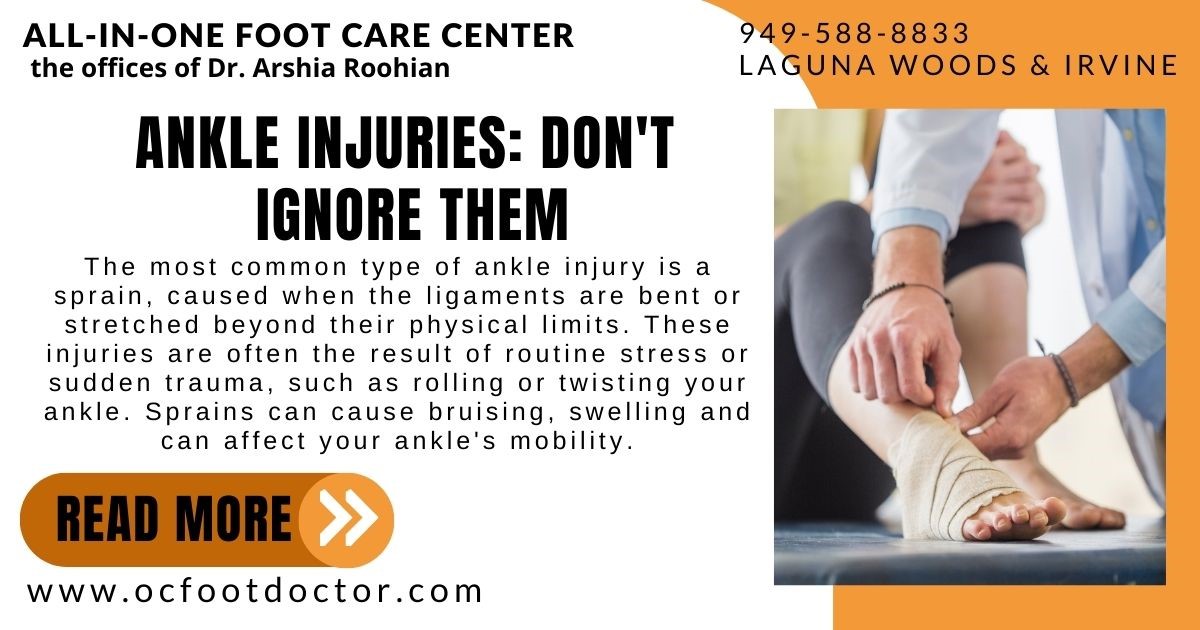Ankle Injuries: Don't Ignore Them

In the beginning, your ankle may seem minor. You may experience swelling or slight discomfort, but you can still walk on it. You continue to work and exercise, but the pain does not completely go away.
There are 28,000 ankle injuries each year, including ligament strains, sprains, and bone breaks. Sports account for half of these injuries. Over time, the range of motion of the joint may decrease or you may experience a debilitating injury.
The alternative to playing through ankle pain is to "walk it off".
What Causes Ankle Injuries?
The most common type of ankle injury is a sprain, caused when the ligaments are bent or stretched beyond their physical limits. These injuries are often the result of routine stress or sudden trauma, such as rolling or twisting your ankle. Sprains can cause bruising, swelling and can affect your ankle's mobility.
- Broken bones, including partial or complete ankle fractures
- Inflammation of the tendons in the joint causes tendonitis
- Gout occurs when the body accumulates too much uric acid
- One or more joints are stiff due to arthritis.
Ignoring an ankle injury can lead to serious consequences
You may notice that your ankle strength and support decrease with time, you cannot put weight or stress on the joint, you feel pain or your range of motion decreases based on past injuries. Scar tissue can be formed when the recovery process is poor or inconsistent, resulting in weakened joints and diminished flexibility.
There is also a possibility that an ankle injury can cause chronic inflammation that will never fully resolve. If you ignore an ankle injury, consider the following:
- Inflammation persists, preventing full healing of ligaments and affecting everyday activities.
- Your gait may be uneven as a result of shifting more weight to one side of your body. Your knees, hips, and spine may be affected as well.
- As you play a sport or stand, you may notice that this creates an unstable joint, which results in stretched out, weaker ligaments.
- Further weakens the muscles and ligaments of the joint, making it vulnerable to future injuries.
- Osteoarthritis is more likely to develop if your ligaments are damaged or weak, as they place greater stress on your joint cartilage.
Ankle Injuries: What to Do
In order to assess the extent of damage, you may need emergency medical treatment or a doctor's appointment based on your ability to walk on it. In the meantime, practice rest, apply ice and compression and elevate your ankle to help the swelling go down. Staying off the joint will allow the tissues to heal and begin to repair. If you don't rest, chronic pain will occur.
Your doctor may recommend the following depending on the degree and type of damage:
- Long-term absence of the ankle
- As the injury heals, an air cast should be worn
- Temporary support with a brace
- If you have suffered a complete tear or another serious injury, you may need surgery
- During recovery, physical therapy will help strengthen the area
You can contact our office at 949-588-8833, or visit our website at https://www.ocfootdoctor.com. Our offices are in Laguna Hills, Irvine, Mission Viejo, Aliso Viejo, Lake Forest, Foothill Ranch, and Costa Mesa.
📲 949-588-8833
🏢 24331 El Toro Rd, Suite 370 Laguna Woods CA 92637
🏢Irvine Medical Arts Building 113 Waterworks Way, Suite 250 Irvine, CA 92618
🌐 https://www.ocfootdoctor.com/
The information contained above is intended for general reference purposes only. It is not a substitute for professional medical advice or a medical exam. Always seek the advice of your physician or other qualified health professionals before starting any new treatment. Health information on this website MUST NOT be used to diagnose, treat, cure or prevent any disease without the supervision of your doctor.


